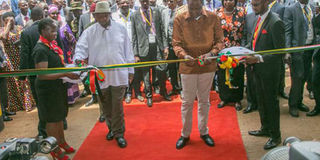And so Presidents Uhuru and Museveni went to the border…

President Uhuru Kenyatta (right) and his Ugandan counterpart Yoweri Museveni commission the one-stop border post in Busia, on February 24, 2018. PHOTO | DPPS
What you need to know:
- There are many social markers near our common borders that speak louder than formal lines on the ground and map.
Last week, after some East African Community palaver in Kampala, President Uhuru Kenyatta and Uganda’s Yoweri Museveni went to launch the one-stop border post in Busia.
For those — and they are surprisingly many — who haven’t travelled through these OSPBs, they are quite revolutionary.
In the past, if you were leaving Kenya for Uganda, you stopped at the Kenya Immigration post and got your travel document stamped.
You then crossed the border through a “no-man’s land” and went to the Ugandan side, where you headed to the Immigration office and got a stamp to enter the country.
Today, that is all gone.
There is one big fancy building as you enter Uganda. You get into it and go the Kenya window, get a stamp.
Then you move to the next, which is Uganda, get a stamp and you walk off into Uganda.
EXPERIENCE
On return into Kenya, there is also just one building, where the same process happens.
Besides how much faster it is, the one-stop border post shatters notions about how the structures of sovereignty and boundaries work in post-colonial Africa.
While you find the same thing between the Botswana and South African borders, there are few places on the continent where you get that experience — except at the OSBPs between Uganda, Rwanda, Kenya and Tanzania.
Yet, dramatic as that is, to the ordinary cross-border people there is nothing to write home about there.
As the East African leaders gathered in Uganda, we were in Kenya at Ukwala, Ugenya, for the funeral of a comrade’s mother.
One of our friends who got hopelessly lost and arrived late half-jokingly said that he knew he had truly lost it when he started “seeing women in busuti”.
Busuti, or gomesi, is that uniquely Ugandan cross between a Victorian robe, dress and Japanese kimono.
RELATIONSHIPS
In other words, there are many social markers near our common borders that speak louder than formal lines on the ground and map.
A few years back, I took a road trip back to my village in eastern Uganda.
On return, I called a taxi from Tororo town to take me to the border so that I could catch a ride back to Nairobi.
The cabbie did many such trips and knew all the officials on the Ugandan and Kenyan sides of the Malaba border by name.
He drove right through the Ugandan border gate and the one on the Kenyan side, waving to the policemen and officials and shouting football things.
IMMIGRATION DESK
I was thrown off my guard a bit and only got a grip on matters when we were on the Kenyan side.
I told him he needed to have stopped at the Immigration desk so that I could get departure and entry stamps on my passports, and we had to go back.
He looked at me, puzzled, and asked: “Why do you need a stamp? Aren’t you from here?”
In other words, if you lived close to the border, you were exempt from the rules that are meant for “the rest”.
So we went back and I did the passport ritual.
As I returned to the car, which was parked near the Uganda exit, the Ugandan policeman messed up with my head further.
“Chief, you came back?” he asked. “When you passed through the first time I thought you were from this area.”
DELEGATES
Everyone understands what “this area” or “here”, in a cross-border context, means, but it is hard to set it out categorically in words.
In 1994 and 1995, during the making of the current Uganda Constitution, a group of delegates tried to.
The Constituent Assembly was sharply divided along two sides.
The majority of the delegates belonged to President Museveni’s ruling National Resistance Movement (NRM) and they favoured the “no-party system” (really a sweeter-smelling version of the one-party state).
A vocal and sharp minority were multipartyists. Suffice it to say the multipartyists lost.
CULTURE
There were many caucuses and committees in the Constituent Assembly but the strangest — and most bi-partisan — of them was the Border Communities one.
As one member said, the “inland people” don’t understand what it means for a man to have his hut exactly on the borderline between Uganda and Kenya, for his first wife’s hut to be on the Ugandan side, and for his second wife’s hut to be on the Kenyan side.
No, they don’t. But the OSBP represents the nationalist ruling elite’s first real step to come to terms with this reality.
Mr Onyango-Obbo is publisher of Africapedia.com and explainer site Roguechiefs.com. Twitter: @cobbo3





